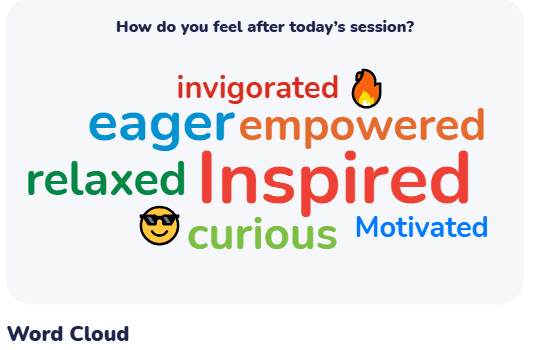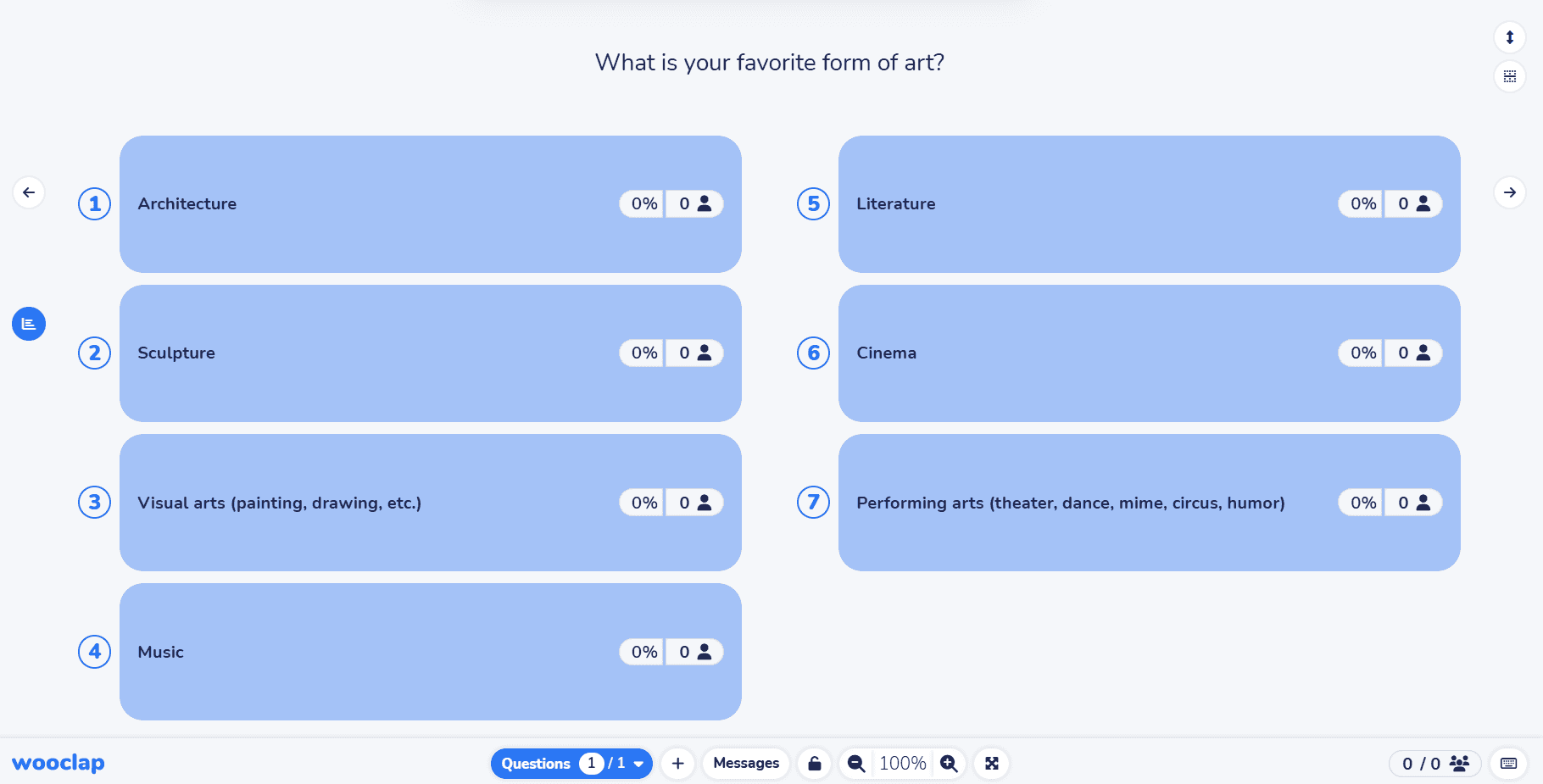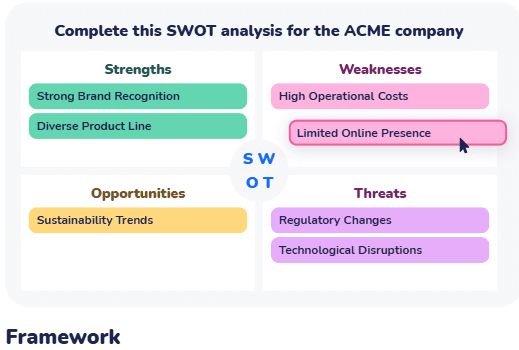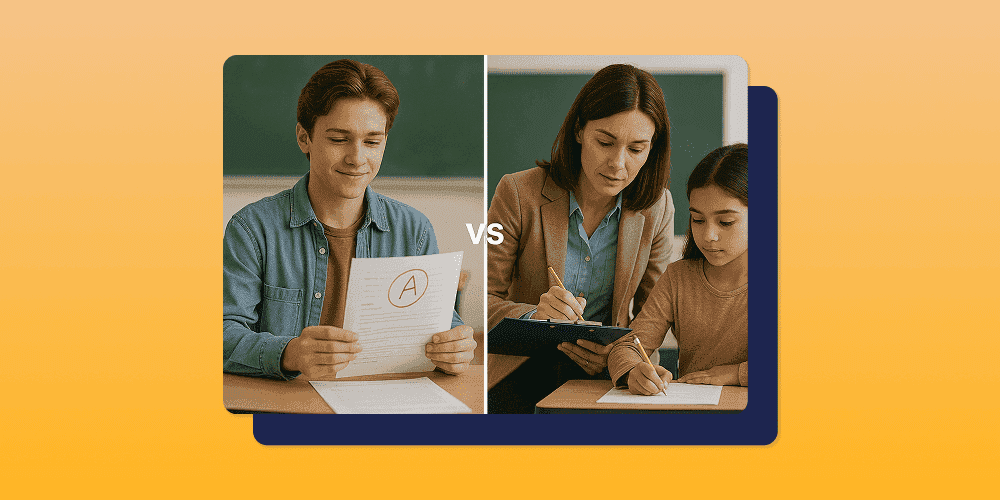
American summer tour! Wooclap will be at InstructureCon 2025
Come say hi at booth 41 from July 22nd to July 24th in Spokane, Washington
5 Types of Formative Assessments Changing Education Today
26.05.2025 • 10 minutes

Every classroom assessment, whether a lively discussion, a raised eyebrow, or a hesitant answer, holds valuable information about student learning.
Formative assessment is the process of capturing and responding to that information. It’s not a single test or worksheet but a dialogue between the teacher and students where ongoing feedback, adjustment, and support are central to learning.
Unlike summative assessment, which evaluates learning at the end of a unit, formative assessment improves learning as it happens. It helps teachers recognize where and how students are thriving or stumbling, often before those patterns appear in summative assessments or final grades. For students, it fosters goal setting, self-awareness, engagement, and a clearer understanding of their learning journey.
Most discussions of formative assessment focus on formative assessment examples, such as exit tickets, quick polls, think-pair-share, or one-minute papers. However, there’s a layer that often goes unnoticed: the types of formative assessments.
These aren’t about which parts of feedback are used, but how it’s used.
- Is it formal or informal?
- Is it delivered instantly or after some reflection?
- Is the activity planned or created on the spot?
- Is it tailored for individual students or small groups?
Understanding these distinctions helps teachers become more intentional, responsive, and creative. This article will discuss the types of formative assessments and how they influence student engagement and educational outcomes.
5 Types of Formative Assessments
Notably, the strengths of formative assessment are its flexibility and versatility. As an educator, you can seamlessly include it in any learning process. However, with so many ways to apply formative assessments, understanding the different types is key to using them effectively.
Below, we discuss five types of formative assessment, examining their definitions, examples, and comparative benefits.
1. Formal and Informal Formative Assessments
Formal formative assessments follow set guidelines, using standardized rubrics or criteria to measure student learning. These can be:
- criterion-referenced, where teachers judge students against specific benchmarks,
- or norm-referenced, where performance is compared against peers.
The key goal of formal formative assessments is to generate objective, measurable data that can inform teaching strategies or indicate readiness for the next phase. Since formal assessments follow clear scoring rubrics, they reduce the chances of bias. They also encourage students to take classwork more seriously.
Examples of formal formative assessments include:
- Short quizzes or polls
- Surveys or questionnaires with multiple-choice answers
On the contrary, informal formative assessments are more flexible and spontaneous.
They don’t rely on grades or formal rubrics. Instead, they’re the quick check-ins and in-the-moment adjustments teachers make naturally during lessons. These include asking open-ended questions, giving exit tickets, observing classroom behavior, or engaging students in reflective group discussions.
Since informal formative assessments aren’t necessarily structured, students can express confusion or make mistakes without any pressure. This fosters more honest and open engagement.
Tools like Wooclap provide solutions for formal and informal formative assessment strategies to make formative assessments even more actionable. For example, formal teaching methods could be using live MCQ and polls, where answers are structured and often scored, similar to an announced pop quiz.
On the informal side, Wooclap’s Word Cloud feature lets students anonymously share their thoughts on a topic. This further offers quick, ungraded insights into student understanding.

2. Immediate and Delayed Feedback Formative Assessments
The debate on whether immediate or delayed feedback is better has likely been due to the highly inconsistent definitions of these terms. Research suggests this inconsistency depends on the type of feedback and the context in which it is given.
So, how do they differ? And when can you use them?
Immediate formative assessments are low-stakes, diagnostic assessments that provide teachers with instant feedback during learning. Students usually provide immediate feedback during or shortly after a learning activity, often within minutes or hours. This helps lecturers engage with students and adjust instruction based on their feedback.
Examples of immediate formative assessments include:
- think-pair-share activities,
- real-time feedback in class,
- quick polls,
- and exit tickets.
A 2024 Edutopia article notes that teachers can seamlessly incorporate think-pair-share into any classroom assessment, requiring as little as five minutes to implement. This quality is also shared by other examples of immediate feedback formative assessment strategies.
Source: https://www.edutopia.org/article/think-pair-share-variations-16-ways-up-your-game/
On the other hand, delayed formative assessments are responses students provide after a time gap.
This gap can range from the next day to several weeks. Common examples of delayed assessments include written comments on assignments or feedback after a comprehensive review. Instructors can also take the initiative with unannounced, ungraded assessments, including pop quizzes.
These quizzes can be given days after a lesson to check what key concepts have stuck. Additionally, these teacher-led formative assessment strategies help surface deeper understanding after students have had the time to process the material.
Research reveals that delayed feedback promotes long-term retention and student knowledge transfer by encouraging reflection.
Source: https://www.edutopia.org/article/think-pair-share-variations-16-ways-up-your-game/
If you want to test this, try Wooclap’s live polls. They can help you gather real-time feedback and adjust instructions accordingly. You could also use its brainstorming feature to get students to process their ideas together, much like think-pair-share activities.
Wooclap’s asynchronous setup supports delayed feedback formative assessment strategies. For instance, instructors can collect student input through surveys. This gives the students time to reflect before responding. Moreover, it allows instructors to review responses thoughtfully before providing feedback.

3. Verbal and Nonverbal Formative Assessments
Verbal formative assessments are spoken interactions between instructors and students.
They provide immediate feedback and targeted support tailored to individual students. During these discussions, you, as the educator, can actively monitor students’ responses for correctness, ask deeper questions, and offer timely intervention.
The idea is that, as students articulate their thoughts aloud, they engage in metacognitive processing.
This means they are more aware of “why” and “how” they understand the lesson. On the other hand, for you, an educator, these conversations are a rich data source because they tell you how to adjust on the spot for more effective teaching.
A few examples of verbal formative assessments include:
- think-pair-share,
- comprehensive checks,
- class discussions,
- and exit tickets.
Meanwhile, nonverbal formative assessments use physical and visual cues to gauge student understanding.
This strategy can benefit students who are hesitant to speak up or express themselves better through visuals or actions. An example of a nonverbal formative assessment is concept maps and graphic organizers, which help students visually structure their critical thinking. Physical cues, like gestures or body language, can also indicate understanding or confusion. One such format is “Fist to Five,” where students show a number from 1 to 5 with their hands to indicate how well they understand a concept.
According to Western Dakota Technical College, facial expressions, posture, and eye contact can also reveal comprehension levels. Similarly, an NIU teaching resource shows that observing student participation in group work can provide information about their learning gaps and engagement.
Sources: https://www.wdt.edu/assets/docs/uploads/ported/2012/12/Formative-assessment.pdf , https://www.niu.edu/citl/resources/guides/instructional-guide/formative-and-summative-assessment.shtml
Whether you rely on verbal or nonverbal cues, Wooclap can help you.
For the former, you can display open-ended questions on-screen using digital tools like Wooclap and encourage students to respond out loud. This fosters critical thinking and helps assess speaking skills or conceptual understanding in real time. For the latter, students can visually organize, share, and connect ideas with Wooclap’s concept maps.

4. Process-Oriented and Product-Oriented Formative Assessments
Process-oriented assessments focus on the active learning process rather than the final result.
They involve continuous feedback during learning activities. This allows you to adjust instruction and meet students’ growing needs. Formative assessments are typically low-stakes, meaning students can take risks and learn without the pressure of high-stakes evaluation.
Examples of process-oriented formative assessments include:
- random observations,
- Self or peer assessment,
- exit tickets,
- short quizzes,
- and quick polls.
On the other hand, product-oriented assessments evaluate students based on the final product of their learning efforts.
At first glance, product-oriented assessments may seem summative, as they focus on final outputs, including projects, presentations, or written assignments. However, they serve a formative purpose when integrated within the learning process and include opportunities for feedback and revision.
This means the product becomes more than just an end result. It is now a reflection point that guides active learning, helping students and instructors identify progress and areas for growth.
For process-oriented formative assessment strategies, opt for tools that allow student engagement, such as live polls or collaborative brainstorming. These promote active participation and give instructors instant insights into student thinking. A platform like Wooclap, for example, lets you try this out easily with features like live polls and brainstorming sessions.

Notably, Wooclap isn’t built to access final products like essays or presentations directly. However, it can support formative product-oriented assessments by helping teachers check in on student progress. The Word Cloud activity especially, allows students to share takeaways, challenges, or reflections during the development phase.
5. Graded and Ungraded Formative Assessments
Although formative assessments are designed to support learning and provide feedback, they can also be used for grading, especially in standards-based systems.
Graded formative assessments are typically low-stakes tasks that contribute to a student’s academic record. However, they have minimal weight in the final grade book. A teaching guide from UIC reveals that graded formative assessments may include in-class work (e.g., one-minute papers, concept maps), discussion forums (e.g., group work, peer assessment), or written assignments (e.g., self-assessments, real-world application tasks).
When used correctly, this strategy motivates students to take ownership of their learning without the pressure typically associated with standardized tests.
Ungraded formative assessments, on the other hand, are purely diagnostic and supportive in nature. They occur during instruction to help both teachers and students identify what’s working and what needs adjustment. ungraded tasks are not meant to evaluate learning at the end of a unit but to influence learning as it happens.
Examples of ungraded formative assessments include peer reviews, self-assessments, exit tickets, random checks, and quick polls.
Since graded formative assessments aren’t heavy-handed, a few low-stakes multiple-choice questions can be enough to gauge understanding and track student progress toward specific learning goals. Wooclap’s Competition mode allows you to add an engaging element by automatically scoring each participant, turning scores into grades.

Additionally, you can send personalized reports to each student, offering tailored insights on their performance. For ungraded assessments, Wooclap offers flexibility across all question types, whether using brainstorming activities, word clouds, or any other question format—to check understanding during a lesson without the pressure of a grade.
Bringing It All Together
At the end of the day, formative assessments aren’t only a classroom tool, they are a mindset. And regardless of which type you settle for, the goal remains the same: to make learning actionable and support student achievement.
A big benefit of formative assessment is its ability to track how students respond to instructional changes over time. It offers real insight into what’s working, what needs adjustment, and how learning is unfolding in real-time. This ultimately improves student performance and drives long-term student achievement.
Digital formative assessment tools like Wooclap amplify this effort by making it easy to assess, engage, and adapt in real-time or asynchronously. Whether you’re in K-12 or higher education, these tools help bring clarity to where learners stand in relation to the success criteria.
For your next lesson plans, think intentionally about the type of formative assessment you're using. And how it can make your students' learning journey more meaningful.
Ready to make your lessons more interactive and impactful? Sign up for the free plan today to start creating interactive lessons and formative assessments.
Writer

The Wooclap team
Make learning awesome & effective
A monthly summary of our product updates and our latest published content, directly in your inbox.



